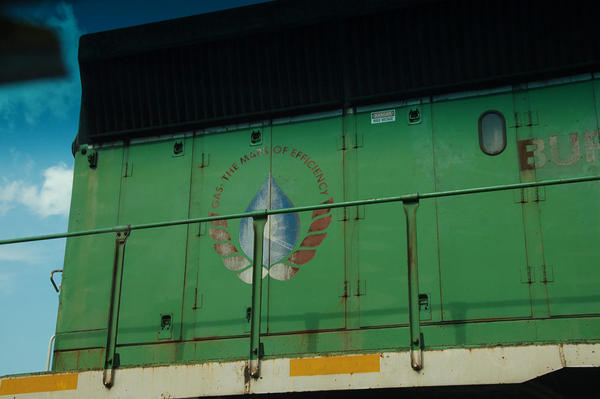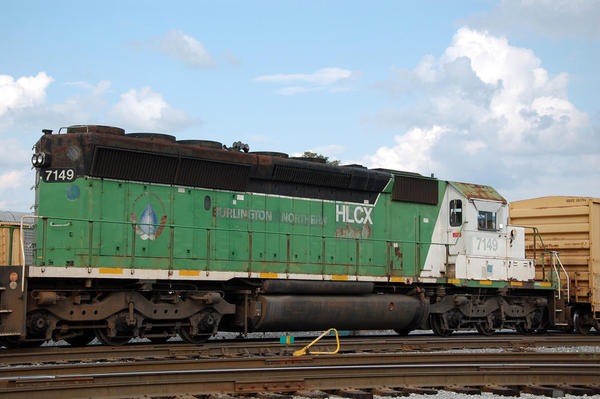The LNG Landscape panelists (pictured, left to right)—GE Oil & Gas Senior Manager John Westerheide, GE Transportation Locomotive Business Operations Executive Graciela Trillanes, Association of American Railroads Assistant Vice President Environmental and Hazmat Bob Fronczak, Clean Energy Fuels Assistant Vice President LNG Production & Rail Koby Knight, and Waste Management Sustainability Services Director Tom Carpenter—addressed technological, operational, economic, regulatory, sustainability, and safety considerations for LNG locomotives and fuel tenders.
In general, “there are huge environmental and economic benefits associated with going to LNG,” Bob Fronczak said. “We believe that LNG’s greenhouse gas emissions will be lower than diesel fuel, able to meet Tier 4 standards, though there is no data at present to support this.”
In terms of reduced fuel cost, a savings of up to $200,000 per year per locomotive (at current LNG prices) is estimated. Test programs at BNSF and Union Pacific are expected to start in the fourth quarter and last at least one to two years. LNG locomotives could be in widespread use by 2016 or 2017.
Development of an industry-standard fuel tender is under the auspices of the AAR Natural Gas Fuel Tender Technical Advisory Group, a joint effort of the AAR Locomotive, Tank Car, and Equipment Engineering Committees. This task force is tackling regulatory and safety issues. For example, under current FEMA rules, LNG is not permitted to move by rail, unless there is an FRA waiver. The committee has met with locomotive builders as a group, and separately, and is working with the FRA to develop national standards for LNG. More than 100 potential failure modes have been identified and submitted to FRA and Transport Canada.
Unlike household natural gas, the odorants (mercaptans) that assist in the detection of a leak cannot be used in a locomotive application. Instead, methane detectors must be in place to detect an LNG leak, because LNG is colorless and odorless. The most vulnerable spots for a leak would be the connection from the fueling facility to the fuel tender, and from the fuel tender to the locomotive.
There are several methods to deliver LNG fuel to the locomotive prime-mover. All require the LNG, which is cryogenic methane chilled to –260 degrees F with other elements (water, propane butane, etc.,) removed, to be vaporized (heated to a gas). This process takes place on the fuel tender. In the engine’s power assemblies (cylinders), diesel fuel, which ignites under high compression, is used to ignite the LNG. This method provides some operational flexibility, depending upon the LNG/diesel ratio. High pressure (5,000 to 8,000 psi) and low pressure (125 psi) fuel delivery methods are being looked at. High pressure fuel delivery requires port or direct injection at the cylinder.
According to Graciela Trillanes, GE Transportation’s method (currently under test at its Erie, Pa., plant) is 80% LNG, 20% diesel, using an existing ECO engine. This ratio allows the engine to revert to 100% diesel in the event of an LNG-related failure or the unavailability of an LNG stationary or mobile refueling station. At a 95% LNG/5% diesel ratio, reverting to 100% diesel is not possible. A 100% LNG engine would require a spark at the cylinder (and major modifications to existing engine technology), since LNG does not ignite under compression. Thus, the “dual fuel” engine appears the way to go, at least until LNG fueling solutions can be deployed industry-wide. Also, as an initial step, deploying 80% LNG locomotives would be an easier, more cost-effective solution for the railroads, according to Tom Carpenter .
Fuel tenders can be configured in two forms, a 10,000-gallon ISO tank, or a 25,000-gallon tender that closely resembles a tank car. An LNG-powered freight train using 25,000-gallon LNG fuel tenders should be able to operate, for example, between Los Angeles and Chicago one-way without a refueling stop, improving locomotive utilization. The ISO LNG tank, though of lower capacity, offers more operational flexibility and potentially lower cost. At 40 feet in length and enclosed in a steel cage, the ISO tank can be mounted in a modified well (doublestack intermodal) car, and can be easily removed when empty and replaced with a full tank transported by truck, thus eliminating the cost and logistical constraints of a dedicated LNG fueling station. For a purpose-built 25,000-gallon fuel tender, for which the AAR is developing a design, the most modern refueling equipment will provide a refueling time of 30 to 45 minutes (about 400 gallons per minute, according to Koby Knight)—longer than a diesel refueling stop, but required less frequently.
Fuel tender safety is of course a prime consideration. In general, LNG is safer than diesel or gasoline, since it does not ignite in liquid form. If it spills, it vaporizes instantly (at –100 degrees F) and dissipates. Dissipation is affected by such factors as humidity and wind. In gaseous form, LNG will ignite only under very specific temperature conditions (a least 1,000 degrees F) and oxygen concentrations. LNG cryogenic tanks, supplied by companies like Chart Industries and Westport Innovations, are highly crashworthy, built to withstand 9 Gs of impaxt force. They are constructed as a double tank—an inner tank (typically stainless steel, though aluminum is sometimes used) encased in a flexible material, and enclosed in a carbon-steel or stainless steel outer tank. A vacuum is created in the space between the inner and outer tanks.
LNG has been in use in the transportation industry (mainly trucks and buses) since the mid-1990s, and was tested on the Burlington Northern Railroad in the late 1980s and early 1990s. (The fuel tenders being prepared for BNSF’s tests with GE and EMD locomotives are BN’s original tenders from those years, rebuilt and modernized). LNG, said Clean Energy’s Knight, “is a sustainability and energy security initiative. The way to make LNG work for the rail industry is through state-of-the-art engine technology and the expertise required for it. The engine technology has come of age. What needs to be carefully look at is the business aspect: What is the cost per hour of operating an LNG locomotive?”
A symposium participant from CN, which began an LNG test program last year using a fuel tender located between two EMD locomotives, said the estimated cost of a fuel tender is $1 million—“a potential complication. The economic analysis lies with the tender.” Operationally, “unit coal trains are a tight operational process and may make the most sense, at least initially, for LNG. And the fastest way to refuel a tender is with an LNG truck. Adding an LNG plant is costly and doesn’t make sense. Using a truck lessens local community concerns, as it does not require pipes, etc. And how many people will be needed for switching and refueling operations?”
These and many other variables will be addressed in the coming months, and at the upcoming High Horsepower Summit in Chicago, Sept. 16-19.













 CN retrofitted two 3,000-horsepower locomotives with engines that run on a fuel mix of 90-per-cent liquefied natural gas and 10-per-cent diesel. (Canadian National Railway)
CN retrofitted two 3,000-horsepower locomotives with engines that run on a fuel mix of 90-per-cent liquefied natural gas and 10-per-cent diesel. (Canadian National Railway)

The long range is a big deal. If one LNG terminal allows out-and-return service for hundreds of miles of radius, and one midpoint terminal allows trans-continental range, that's pretty much all that's required for a very rapid conversion of the fleet. That and a bi-fuel retrofit system which can be installed quickly could make the RRs more or less petroleum-free in short order.
The Dresser-Rand micro-LNG plants look to be perfect as part of a "starter kit". 100k GPD is 4 dual-locomotive trains-worth, or 8 single-loco trains-worth.
Posted by: Engineer-Poet | June 05, 2013 at 08:43 AM
A few years ago, I would have predicted that some of the major freight lines would be electrified as a result of the high cost of diesel fuel but now I think we will see expanded use of LNG long before we see any major electrification. The Westport dual injection system allows the engine to run as a true diesel with anywhere from 0 to about 95% of the power coming from natural gas.
Posted by: sd | June 05, 2013 at 01:21 PM
LNG conversions don't require lots of new infrastructure under hundreds of taxing authorities, so we can expect them to be more attractive to the bean counters.
Posted by: Engineer-Poet | June 05, 2013 at 02:18 PM
Add a garden hosepipe to a LNG tanker and it can allow any locomotive to run on part LNG and save a lot of money. A CNG tanker or set of tankers can work the same. Just push the hosepipe into the air intake and open a valve slightly. A Stirling company in the Netherlands can make a unit to make the LNG or to keep it cold. ..HG..
Posted by: Henry Gibson | June 06, 2013 at 04:56 AM